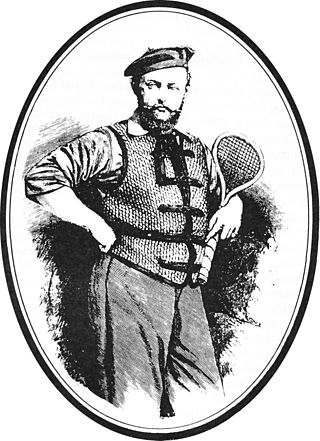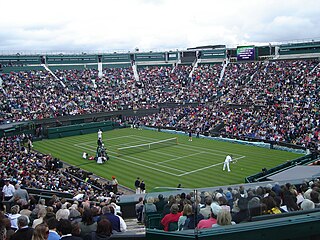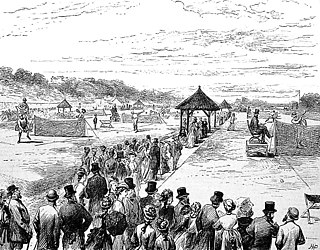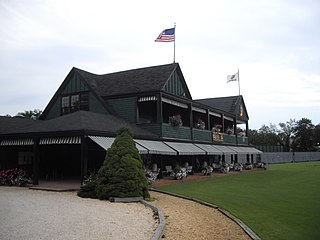
1859 in sports describes the year's events in world sport.
Edgbaston is a suburb of Birmingham, West Midlands, England. It lies immediately south-west of Birmingham city centre, and was historically in Warwickshire. The wards of Edgbaston and North Edgbaston had a combined population of 42,295 at the 2021 census.

Major Walter Clopton Wingfield was a Welsh inventor and a British Army officer who was one of the pioneers of lawn tennis. Inducted into the International Tennis Hall of Fame in 1997 as the founder of modern lawn tennis, an example of the original equipment for the sport and a bust of Wingfield can be seen at the Wimbledon Lawn Tennis Museum.
Sport has always been important in Birmingham, England, from the hundreds of diverse grass-roots sports clubs to internationally famous teams, associations and venues.
Joaquín Loyo-Mayo was a left-handed Mexican tennis player who was active from in the 1961 and 1982 and won 21 career singles titles.

George Dixon was an English Liberal Party then Liberal Unionist politician who was active in local government in Birmingham and sat in the House of Commons in two periods between 1867 and 1898. He was a major proponent of education for all children.

The racket sport traditionally named lawn tennis, invented in Edgbaston, Birmingham, England, now commonly known simply as tennis, is the direct descendant of what is now denoted real tennis or royal tennis, which continues to be played today as a separate sport with more complex rules. The first Lawn Tennis Club and tournament was held in Royal Leamington Spa on 1 August 1882.

The 1877 Wimbledon Championship was a men's tennis tournament held at the All England Croquet and Lawn Tennis Club in Wimbledon, London. It was the world's first official lawn tennis tournament, and was later recognised as the first Grand Slam tournament or "Major". The AEC & LTC had been founded in July 1868, as the All England Croquet Club. Lawn tennis was introduced in February 1875 to compensate for the waning interest in croquet. In June 1877 the club decided to organise a tennis tournament to pay for the repair of its pony roller, needed to maintain the lawns. A set of rules was drawn up for the tournament, derived from the first standardised rules of tennis issued by the Marylebone Cricket Club in May 1875.

Major Thomas Henry Gem, known as Harry Gem, was an English lawyer, soldier, writer and sportsman.

Juan Bautista Luis Augurio Perera Orfila, known as Augurio Perera, was a Spanish-born merchant and sportsman based in England, credited alongside his friend Harry Gem as a lawn tennis pioneer.

Birmingham is a city and metropolitan borough in the metropolitan county of West Midlands in England. It is the second-largest city in Britain – commonly referred to as the second city of the United Kingdom – with a population of 1.145 million in the city proper. Birmingham borders the Black Country to its west and, together with the city of Wolverhampton and towns including Dudley and Solihull, forms the West Midlands conurbation. The wider metropolitan area has a population of 4.3 million, making it the largest outside of London.

Powelton Club is located between US 9W, Interstate 84, Balmville Road and Chestnut Lane in the hamlet of Balmville, New York, United States, just north of the city of Newburgh, in the Town of Newburgh. Originally established as an archery club, it is one of the five oldest golf courses in the state, and the ten oldest in the U.S. It has been listed on the National Register of Historic Places since 1999.

The Seabright Lawn Tennis and Cricket Club is a historic private sports club in Rumson, Monmouth County, New Jersey, United States. Founded in 1877 and incorporated in 1886, it is one of the oldest active tennis clubs and claims to be the oldest lawn tennis club in the United States. Most of the club's present facilities were designated a National Historic Landmark in 1992 in recognition of this history.
The Edgbaston Priory Club is a private members' tennis, squash and leisure club in Birmingham, England. The club is the host of the annual WTA Tour stop, the Rothesay Classic. The 'Ann Jones Court' stadium has a capacity of 2,500 people.
The Midland Counties Championships also known as the Midland International was a grass court tennis tournament held at Edgbaston Cricket and Lawn Tennis Club, Edgbaston, Great Britain from 1881 to 1977.
Westbourne Road Town Gardens, or Westbourne Road Leisure Gardens, is a group of allotments in Edgbaston, Birmingham, England, created in 1844. It is listed Grade II in Historic England's Register of Parks and Gardens.
1876 Women's Tennis Season was mainly composed of national and local amateur tournaments. This year two tennis events were staged in Dublin, Ireland and Hamilton, Bermuda between April and December 1876.
The Edgbaston Open Tournament was an early Victorian era men's and women's grass court tennis tournament first staged in June 1881, at the Edgbaston Cricket and Lawn Tennis Club, Edgbaston, Warwickshire, England. This distinct tournament ran until 1908.
The Priory Whitsun Lawn Tennis Tournament also known as the Priory Open Lawn Tennis Tournament, or the Priory Club Tournament was a men's and women's grass court tennis event established in 1920 that ran until 1960. In May 1963 the Priory Club was destroyed by a fire, and in 1964 it merged with the Edgbaston Cricket and Lawn Tennis Club to form the Edgbaston Priory Club.
The Tally-Ho! Open Tennis Championships also known as the Tally-Ho! Hard Courts, was a combined men's and women's clay court tennis tournament originally founded in 1923. The tournament was held at the Tally Ho Lawn Tennis Club, Edgbaston, Birmingham, England until 1982.










